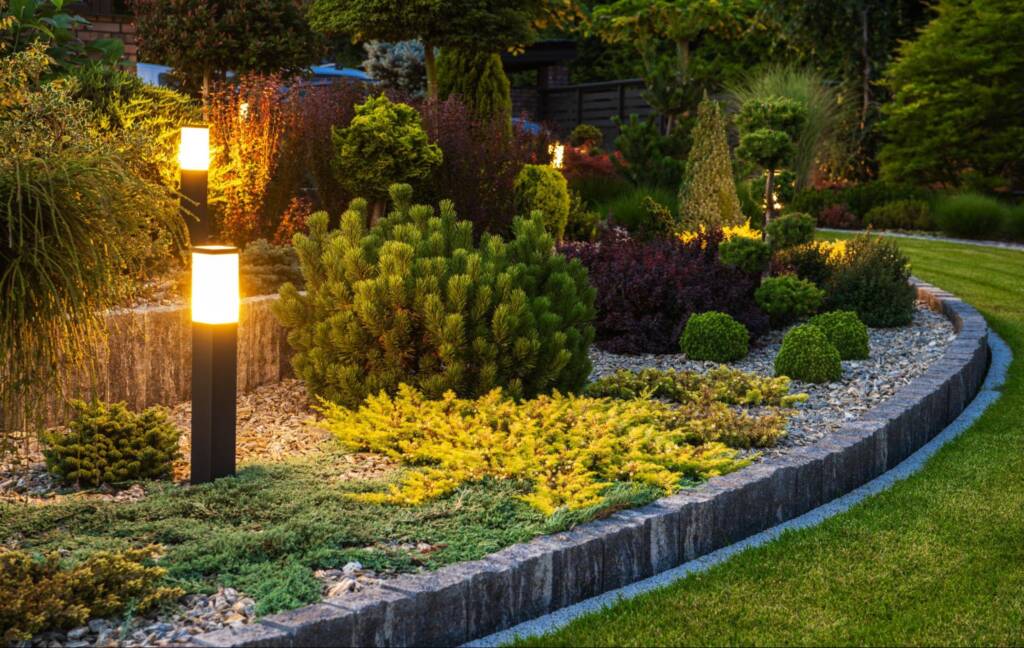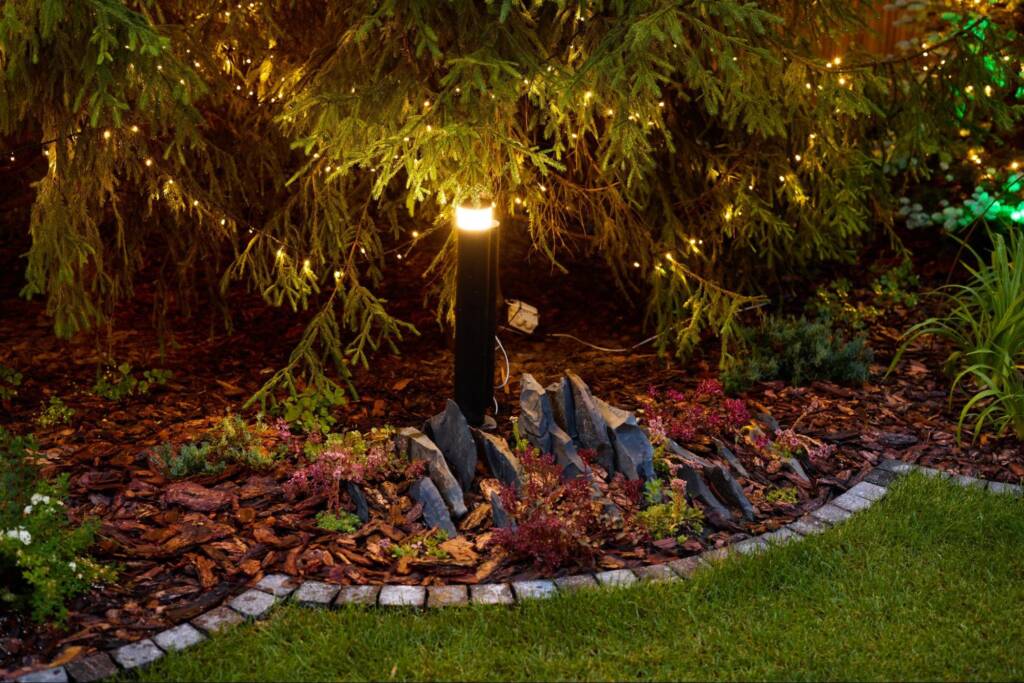A dark yard can feel empty, even eerie, once the sun goes down. But with the proper outdoor lighting, that same space becomes inviting, secure, and alive with character. Homeowners are reimagining their backyards as extensions of their homes. Landscape lighting is no longer just about visibility; it’s about design, warmth, and functionality. Your outdoor space deserves to be enjoyed long after sunset.
Landscaping Lights Change How You Use Your Yard
Outdoor lighting isn’t just for show; it shapes how your space functions at night. From safety to style, the proper setup can make all the difference. It guides movement, sets the tone, and highlights what matters. A well-lit yard becomes a place you want to spend time in.
Landscaping Lights Define the Mood Outdoors
Thoughtfully placed lights can shift the entire tone of a yard. Whether you’re hosting friends or winding down after work, the ambiance matters. Lighting influences how spaces feel without changing a single plant or structure. When done right, it creates a setting that feels personal and comfortable.
Sets the Atmosphere With Strategic Lighting
The atmosphere of an outdoor living space depends heavily on the tone of the light. Warm lighting creates a cozy, intimate setting ideal for social evenings. Cool lighting feels clean and bright, making it better suited for activity-focused areas. Uplights on trees offer drama, while downlights create softness. Different zones benefit from other styles, so variety is essential. Adjusting the light’s direction and spread gives each space a unique personality.
Creates Visual Comfort After Dark
Lighting should make nighttime spaces comfortable for the eyes. Bright lights with no diffusion can cause glare, which ruins the mood. Instead, use frosted lenses or indirect lighting to soften brightness. Place fixtures at angles that reduce harsh contrasts. Consistent light levels help guests move around safely and confidently. With balance and planning, outdoor lighting can feel natural rather than staged.
Landscaping Lights Increase Safety and Security
When outdoor areas are dark, the risks increase. Accidents are more likely, and intruders see opportunities. Proper lighting minimizes both. It offers peace of mind for you and your family.
Guides Footsteps and Prevents Hazards
Steps, walkways, and uneven terrain all become hazards at night. Pathway lights clearly define these areas to prevent accidents and falls. That is especially helpful for kids, older adults, or guests unfamiliar with the layout. Low-voltage lights can be spaced along the ground for subtle guidance. Step lights installed into risers add another layer of visibility. Planning for safety doesn’t mean sacrificing aesthetics.
Deters Unwanted Attention
A well-lit yard is less inviting to trespassers. Darkness hides movement, but light exposes it. Install motion-sensor lights at entry points and perimeter areas. They conserve energy while still providing immediate coverage when needed. Constant, low-level lighting along fences or walls creates a subtle sense of security. Criminals are far less likely to target a home that appears occupied and watched.
Properly Lighting Entrances and Exits
Doorways, gates, and garages need extra attention. These are natural choke points where visibility should never be compromised. Wall-mounted sconces or overhead lights brighten entrances without blinding the viewer. Consider symmetry to improve appearance and ensure coverage. Lighting these access points also helps guests feel more welcome. It shows thought and preparation.

Landscaping Lights Highlight Design Features
Your yard has standout elements that shouldn’t disappear at dusk. Trees, gardens, and hardscape features all deserve their moment. Landscape lighting helps shape how they’re seen and appreciated.
Showcases Plants, Trees, and Water Features
Lighting brings life to plants even after the sun sets. Spotlights can draw attention to trees with interesting bark or shapes. Uplights from beneath large leaves or bushes create a dramatic effect. Water features, such as fountains or ponds, reflect light in motion. A soft underwater glow adds elegance and mystery. Together, these choices turn natural beauty into nighttime art.
Adds Depth and Dimension to Outdoor Spaces
Good lighting makes a flat yard feel dynamic. Layered lighting introduces visual contrast, breaking up the space and creating a more dynamic environment. Techniques like grazing emphasize texture on stone walls or tree bark. Shadowing adds mystery and interest without using more fixtures. Silhouetting outlines shapes and keeps focal points strong. These tricks work together to add a richness that changes as you move through the yard.
Draws Attention to Architectural Details
Outdoor structures deserve light, just like the plants around them. Pillars, pergolas, and built-in seating areas can stand out with proper lighting. Grazing lights up walls with texture, while soffit lights enhance overhangs. Use light to mirror shapes already found in your home’s design. It creates consistency from the inside out. Highlighting architecture keeps the whole property feeling cohesive.
Landscaping Lights Support Outdoor Living
The right lights can double your outdoor use. Daylight hours are limited, but lighting adds a sense of freedom. It lets your outdoor space function any time you need it. Comfort and practicality both benefit.
Extends Usable Hours Outside
Without light, nights end too early. But light over a dining area or seating zone invites you to linger. Add string lights, wall sconces, or post lights to enhance the ambiance around decks and patios. Task lights are helpful when cooking or reading outdoors. Ambient light makes spaces feel calm and welcoming. You’ll start planning more evenings outside naturally.
Creates a Seamless Transition Between Indoor and Outdoor
Your home doesn’t stop at the back door. Match your outdoor lighting to the temperature and brightness of your interior lighting. It reduces the harsh jump between spaces. When lights are coordinated, outdoor rooms feel more like home. Try using the same finishes or styles on fixtures both inside and out. Flow matters when design and comfort are priorities.
Supports Social Gatherings and Privacy
Lights bring people together, but they can also create boundaries. Use lighting to define zones for eating, relaxing, or games. Privacy lighting around fences or trees helps the yard feel like a retreat. Shielded fixtures keep light from spilling into neighbors’ yards. Use dimmers to match the mood to the moment. Lighting should serve both gathering and solitude.

Choosing the Right Landscaping Lights
Picking fixtures is about more than looks. It’s about purpose, placement, and longevity. A little planning saves time, energy, and cost down the line. The proper lighting also complements your overall landscape design, tying the entire space together.
Types of Outdoor Lighting Fixtures
Each fixture serves a unique purpose in the landscape. Path lights serve as a guide and define the edges. Spotlights draw focus to plants or objects. Wall lights add wash lighting for large areas. Well lights or recessed lighting can stay hidden while lighting upward—select materials that withstand the weather and a finish that complements your home’s style.
Light Placement and Layering Techniques
Layered lighting creates comfort and usability. Combine ambient, task, and accent lighting to shape your space. Start with general coverage, then fill in with focused light. Avoid over-lighting, which flattens depth and wastes energy. Keep a balance between light and shadow. A thoughtfully lit yard feels alive, not artificial.
Matching Lighting Style With Landscape Design
Consistency builds visual harmony. Match your lighting style with your garden’s overall look—a modern yard pairs well with sleek, minimal fixtures. Rustic spaces can use bronze finishes or lantern-inspired designs. Make lighting part of your design process, not an afterthought. Cohesion makes every element feel intentional.
Landscaping Lights As a Long-Term Investment
Outdoor lighting isn’t just a luxury; it adds real value. It shapes the way people perceive, experience, and evaluate your property. Thoughtful lighting boosts both lifestyle and resale benefits.
Boosting Property Value and First Impressions
Well-lit homes photograph better and appear more appealing at night. Real estate agents often note how outdoor lighting improves curb appeal. It frames the house and highlights landscaping that might go unnoticed. Prospective buyers see the yard as usable, safe, and stylish. Even minor lighting improvements can make a home more memorable. That makes it easier to attract the right buyer.
Energy Efficiency and Low-Maintenance Solutions
Today’s systems are more intelligent and less expensive to operate. LED lights use less power and last for years. Solar options are improving and reducing the need for wiring. Smart timers and motion sensors minimize waste. Fewer bulb changes and repairs result in lower long-term costs. It’s a system that works for your wallet and the environment.
Planning for Growth and Upgrades
Start simple, then add more as your needs change. Begin with path lights and basic safety lighting. Over time, layer in accent lights or innovative features. Use transformers that support expansion. Planning for flexibility saves future headaches. Your yard will grow, and your lighting should grow with it.
Brighten Your Outdoor Space With Landscaping Lights
Every night that passes is one less chance to enjoy your yard fully. Outdoor lighting isn’t just an upgrade; it’s a way to take control of your space. You’ve invested time and care into your home; lighting makes sure it shows. Start small or go bold, but act while the season is right. Your yard deserves more than darkness.
See what’s possible with expert landscaping lights. Read more on the Brady Landscaping & Construction blog.
